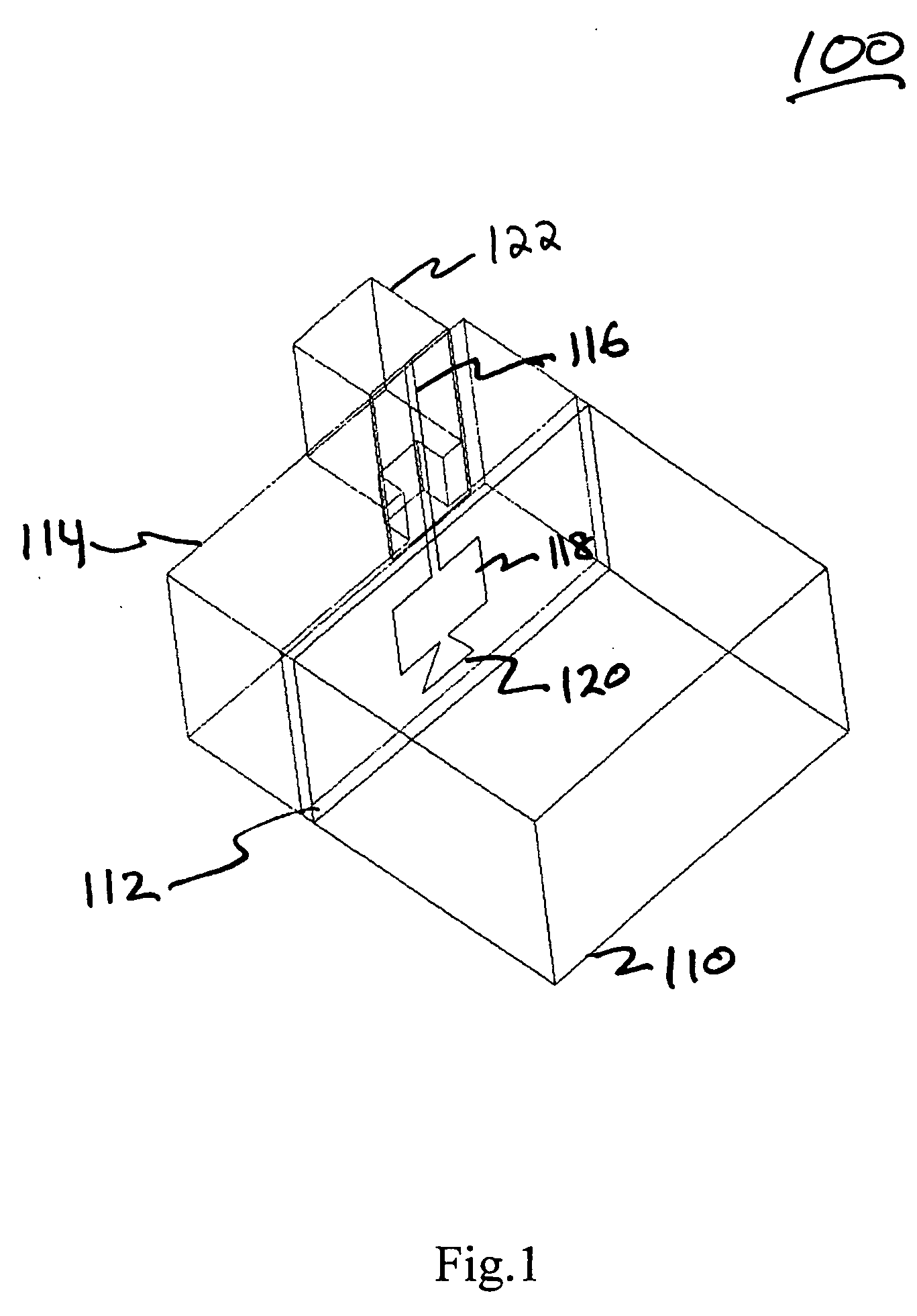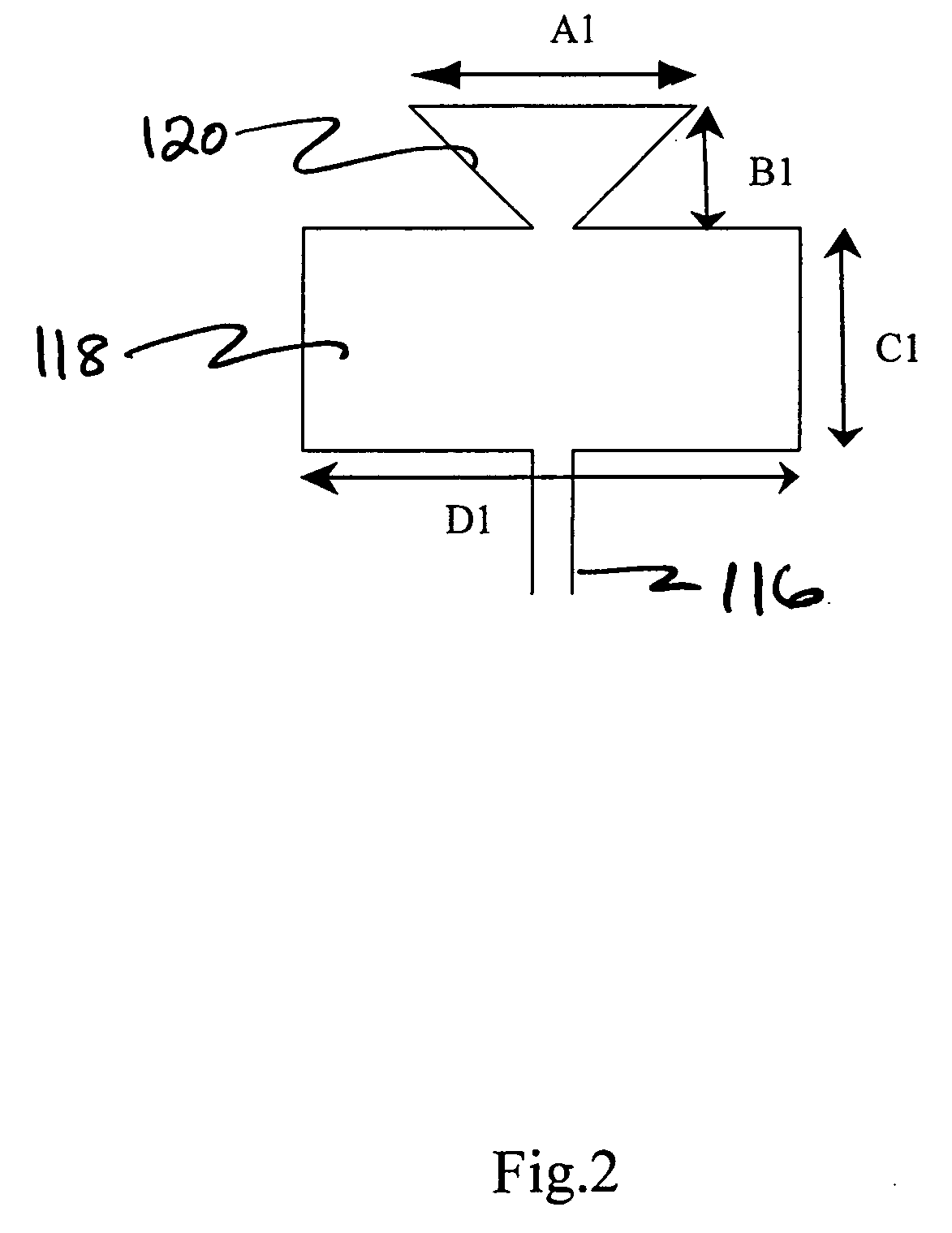Apparatus and method for waveguide to microstrip transition having a reduced scale backshort
a waveguide and microstrip technology, applied in electrical apparatus, multiple-port networks, resonances, etc., can solve the problems of difficult to properly realize matching circuits, difficult to match open-ended waveguides, and constraint that the backshort b>1514/b> has a considerable length, so as to reduce the scale
- Summary
- Abstract
- Description
- Claims
- Application Information
AI Technical Summary
Benefits of technology
Problems solved by technology
Method used
Image
Examples
first embodiment
[0036]FIG. 1 shows a transition 100, passing electromagnetic (EM) waves between a waveguide and microstrip consistent with the present invention. Transition 100 includes an open-ended waveguide 110, a substrate 112, a backshort 114 having reduced scale, a microstrip 116, a resonator 118, and a conductor pad 120.
[0037] As used herein, the expression “reduced scale” may refer to a reduction is the size of the backshort 114 in any dimension; and includes reductions of size in the dimension of EM wave propagation. For example, reduced scale backshort 114 may include a backshort having a dimension in the direction of EM wave propagation which may be less than or equal to a quarter wavelength (λ / 4) of the EM wave. It should be noted that the reduced scale backshort 114 dimensions may be arbitrary and are not limited only to integer fractions of a wavelength (λ).
[0038] Embodiments of the invention typically may utilize EM waves having frequencies in the microwave region. However, the EM w...
second embodiment
[0058]FIG. 6 shows the results of an exemplary simulation estimating the frequency performance associated with the invention shown in FIG. 5. This graph shows the magnitude of the impedance associated with parameters of a scattering matrix, S11 and S21, over a frequency range of 8.5 GHz to 10.5 GHz. S11 may be associated with the magnitude of a reflecting EM wave, and S21 may be associated with the magnitude of a EM wave passing through transition 500. As before, S11 and S21 represent values that can be measured between the edge of open-ended waveguide 110 and the edge of microstrip 116.
[0059] As can be seen from FIG. 6, the curve simulating the magnitude S11 shows a “dip” around 9 GHz where EM energy associated with desirable frequencies tends to not be reflected. In this embodiment, reflections may be attenuated approximately −15 dB around 9 GHz. While this attenuation level may be less than that shown in FIG. 3, it may be sufficient for applications where transition 500 can be us...
sixth embodiment
[0069]FIG. 12 shows the results of an exemplary simulation estimating the frequency performance associated with the invention. This graph shows the magnitude of the impedance associated with parameters of a scattering matrix, S11 and S21, over a frequency range of 8.5 GHz to 10.5 GHz. S11 may be associated with the magnitude of a reflecting EM wave, and S21 may be associated with the magnitude of a EM wave passing through transition 1000. As before, S11 and S21 represent values that can be measured between the edge of open-ended waveguide 110 and the edge of microstrip 116.
[0070] As can be seen from FIG. 12, the curve simulating the magnitude S11 shows a steep “dip” around 9 GHz where EM energy associated with desirable frequencies tend to not be reflected. This embodiment has the advantage of not only attenuating reflections by approximately a steep −45 dB around 9 GHz, but also reflects undesirable frequencies as shown by the “bump” is S11 at 10 GHz. The curve simulated the magnit...
PUM
 Login to View More
Login to View More Abstract
Description
Claims
Application Information
 Login to View More
Login to View More - R&D
- Intellectual Property
- Life Sciences
- Materials
- Tech Scout
- Unparalleled Data Quality
- Higher Quality Content
- 60% Fewer Hallucinations
Browse by: Latest US Patents, China's latest patents, Technical Efficacy Thesaurus, Application Domain, Technology Topic, Popular Technical Reports.
© 2025 PatSnap. All rights reserved.Legal|Privacy policy|Modern Slavery Act Transparency Statement|Sitemap|About US| Contact US: help@patsnap.com



